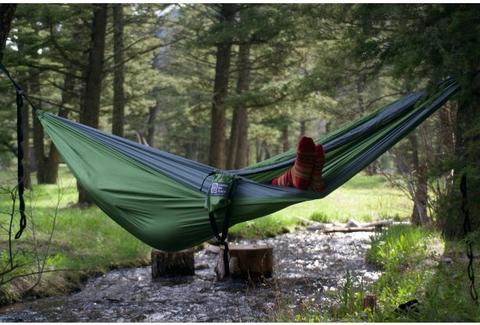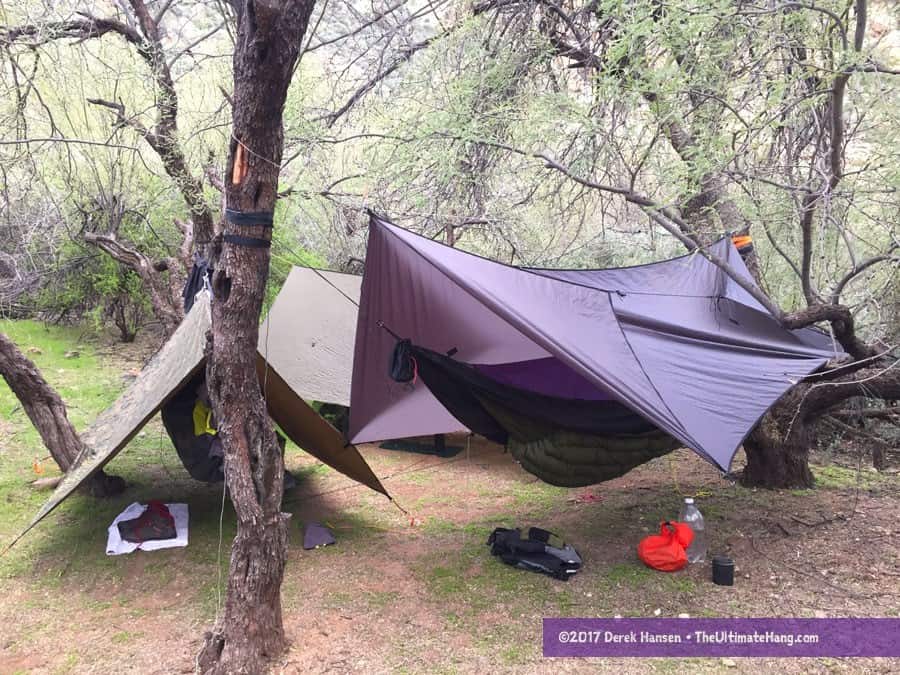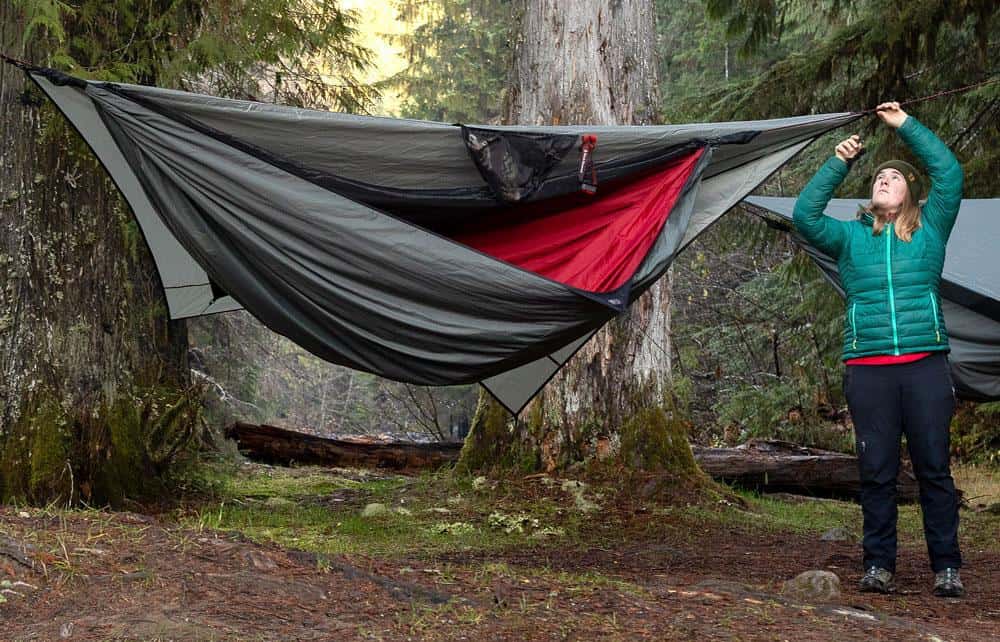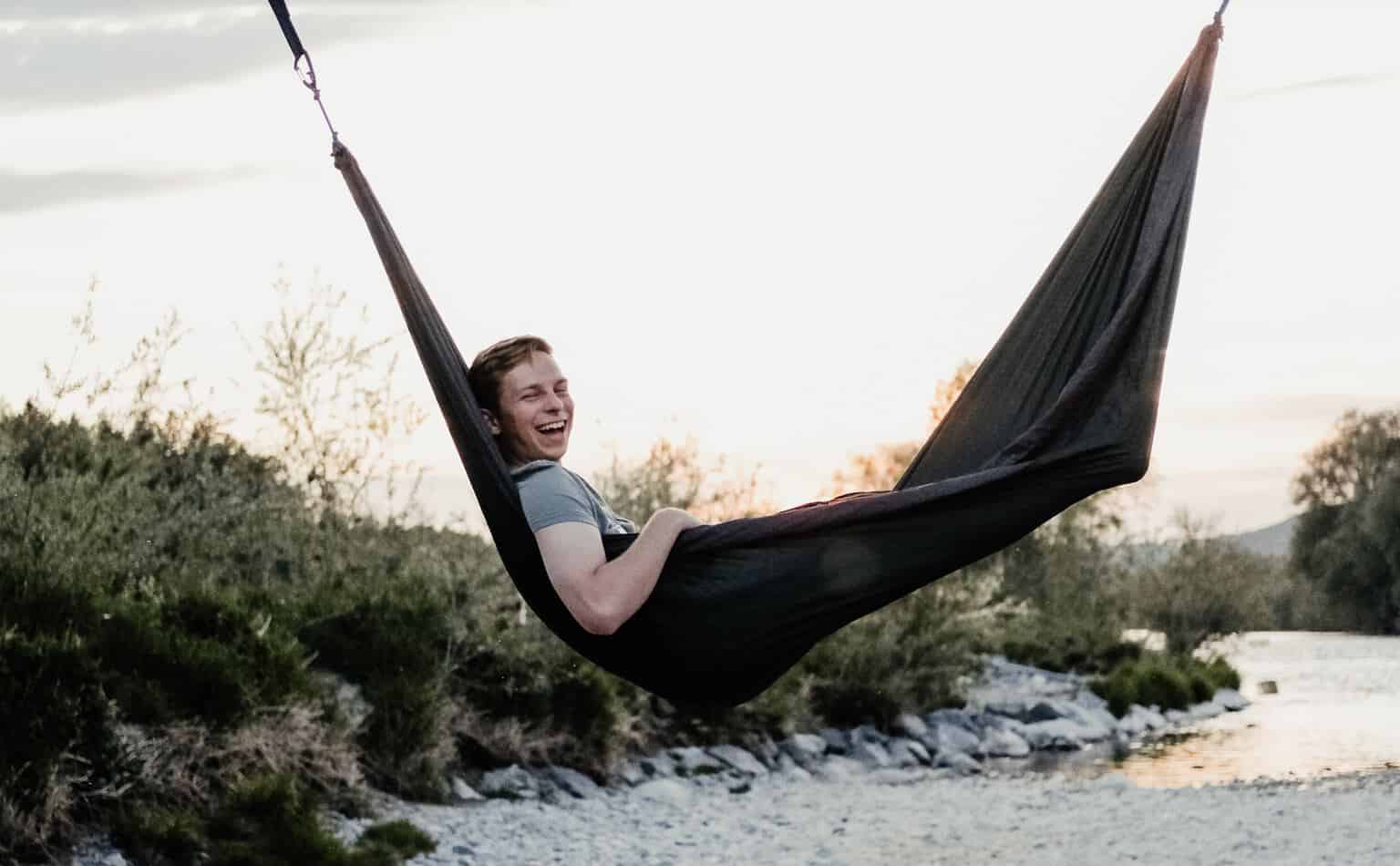Considering I have a up and coming bicycle tour in Europe. I was thinking about changing things up and instead of sleeping in a tent maybe try and bicycle tour with a hammock. I have never really tried camping in a hammock at all let alone on a bicycle tour. I think it would be a way to change it up a bit and just make my experience a little different from my other bike adventures.
So, should you bring a hammock on a bicycle tour or bikepacking adventure? Well I am going to try and help you come to a decision in this article. But I have come to the conclusion that it comes down to the individual. Some people can manage sleeping in a hammock and others struggle.
It seems very practical considering hammocks pack light and take up less space than a standard 1 or 2 men tent. I have also been thinking about just setting up a lightweight tarp and run it off the bike. But that is for another article, today we will talk about the logistics of camping in a hammock while bicycle touring.
Tent or Hammock?

This is the question I am asking myself at the moment, sure you can take both a tent and a hammock if you are bicycle touring with panniers. And if your tent is lightweight and takes up very minimal space like the Big Agnes Copper Spur UL2 Classic Tent. This might be something I will do, just to see if sleeping in a hammock is for me. And by any chance if not then I still have the tent.
But it seems if you choose to opt for a hammock setup it is less costly compared to buying a tent.
Price, Size and Weight comparison

Tents can cost much more than a hammock ranging from $200 to $500. When you can pick up a hammock suitable for bicycle touring for a low as $69.95. While a top of the range Hennessy Hammock can set you back $180. Which is actually pretty damn good compared to a tent. The Hennessy also has a mosquito mesh and a rainfly tarp. You can pay $340 for a tent that weighs 5 lb 8 oz or about 2.5 kg. When the Hennessy Hammock is about 3.75 pounds or 1.7 kg. Although my Denali Zephyr I Hike Tent weighs about 1.9 kg. Having less things for a sleeping setup, like tent poles and pegs and slightly less weight to carry. That is a win for me!
Is Hammock Camping Comfortable? Cons to sleeping in a hammock

There are a few things you should consider if you are thinking about bike touring with a hammock. First downside is well if there is no trees then, yeah, good luck. I could imagine it riding across the Nullarbor there is no chance for a hammock. But if you only have a hammock, you are kind of stuck in having to always camp where there is trees. And this can be a pain sometimes. I have camped in many diverse locations and sometimes there is no trees around, but there is a possibility to improvise. Also with the trees you may find you are camping around many but they are not spaced apart for the most appropriate hammock setup.
Furthermore, you may get wet if the rainfly is not setup correctly. Also if the material of your hammock is not durable or thick, mosquitoes may bite you. This can be prevented with a sleeping pad or the Hennessy Hammock actually has high density bottom fabrics to resist mozzies. If it gets too cold you may have trouble. At times without a proper insulated hammock the cold are will hit your back. This can be prevented by using a insulated sleeping pad. But even then when laying down you may find that you slide off the sleeping pad and get tangled in your sleeping bag, trying to get comfortable. If you don’t setup the hammock correctly it may make it difficult to get a good night sleep.
Having that said, they do say hammock sleeping, when done right, is the best form a sleeping. Studies have proven that we are able to sleep deeper in a hammock compared to our own beds.
But having that said, if you find it difficult to pitch your hammock in trees due to there simply being not trees. If your setup also includes a tarp. You can be resourceful and use the tarp as a stand alone shelter.
Bike Tarp Shelter! Bikepacking Tarp Setup
We will come back to hammocks, just for a moment I want to discuss bike tarp setups for camping. As a alternative camping option. It is a great idea for a minimalist camping shelter solution if done right. You don’t require much camping gear, and your bike is the main component of the tarp setup followed by the tarp itself.
This shelter is a very resourceful solution that is fairly easy to setup.
What you may need:
- A Tarp
- Something to hold down your break lever (Velcro strap)
- 2 X Guidelines
- 2X Micro Carabiners
- Tent Stakes
- Other Camping gear like (Sleep pad, Sleeping Bag, Pillow, Etc)
In terms of the pitch you can get creative and do what works for your tarp design and setup. But all you are doing is pitching the tarp over your bike creating a space to keep your sheltered from the elements.
Best Tarps for Bike Camping
When looking at a tarp for bike camping you want something that is lightweight and will pack down to a smaller volume. If you can try and avoid poly tarp as this is a more heavier tarp that is available on the market.
Most tarps are silnylon, silpoly, or cuben fiber. Weighing between ~5 oz and ~ 14 oz (141 grams to 397 grams) for full rain coverage. Which works out to be better than in a tent.
Pros to using a hammock for bicycle touring
If there is many trees where you are touring then the advantage of a hammock is a huge increase in suitable campsites. With a hammock you don’t need to search for flat ground, clear from rocks and sticks. Keeps you up of the ground away from the creepy crawlies and snakes, well until it is time to get out of the hammock. Save you from waking up in a huge puddle of water. This has happened to me once in my tent, got a lot of rain that night. A good way to make some new friends, let’s’ admit it, hammocks are cool. You can actually use the hammock as a camping chair. Hammock are a leave no trace kind of camping style. You are not disturbing the environment by more around scrub and making the ground suit a clear surface for the base of your tent. Most hammocks come with wide webbing straps that protect the bark on the trees.
One of the great things about hammock camping, with the tarp if it starts raining you can just set up the tarp and get all your gear under and cook while keeping dry.
Using a hammock on a bicycle tour is a bit of a learning curve to get it right. And it is an art to setting up a hammock and sleeping in one. But once you figure out how everything works hammocks can be a great alternative the sleeping in a tent.
Hammock Camping Tips
Using a hammock is a art, and takes a few attributes when done right to result in a pleasant hammock camping experience.
- Have some sag in the hammock : When setting up the hammock you don’t want to have it to tight between anchor points as this can result in pain in the shoulders and it will not be comfortable. It is best to allow for a sag almost like the hammock takes a form of a smily face. A deep sag also makes the hammock harder to fall out of.
- Lay diagonally across the hammock : This is the most comfortable way to lay in a hammock, it was how they were designed to be used.
- Raise the foot end to be higher : You may find that you slide into the centre of the hammock, to prevent this you can slightly raise your foot end.
- Use a sleeping pad or quilt : you may not think that you need the padding of a sleeping pad. You are right but you will still need a pad or quilt to insulate your back side when sleeping in the hammock. As this will reduce wind convection. A recommended quilt is the OneTigris Holofil Underquilt which works great. Also if you are using a sleeping pad, it most likely will slide around. To prevent this put it in the sleeping bag.
- Get a hammock with a bug net : Most quality camping hammocks come with sewn-on bug netting. But just make sure when you are looking for a hammock that they have one.
- Put something under your knees : If you are too tall for your hammock you may experience hyperextension of your knees when laying diagonally across your hammock to prevent this put some extra clothes or a pillow under your knees.
How To Set Up A Hammock
Best Hammocks For Bikepacking and Bike Touring
Dutchware Chameleon Hammock

“The Dutchware Chameleon is a modular hammock that starts with an open hammock with the addition of a zip-off bug net, winter cover, and other accessories. What really makes the Chameleon stand apart from other modular hammocks is the proprietary fabrics, suspension system, and the reversible zipper that is toothed rather than coiled that allows the bug net and winter cover to be completely removed and flipped so you can change the direction of the lay from left/right to right/left as desired. This means that a single hammock design can suit the needs of most without requiring a special order.”
Buy Now from $125
Hennessy Explorer Hammocks – Hennessy 4Season Explorer XL Zip

“This 4Season system has advantages when you find yourself in colder weather than expected because it can be adjusted to a wide range of temperature conditions without adding weight or bulk.
With just the oversize open cell foam pad, most people are comfortable down to about 40 F / 4 C. Adding the space blanket under the pad should take you down to below freezing. The space blanket can be placed above or below the pad depending on the temperature, humidity and what works best for you.
If you have been wearing a jacket during the day, spread it out on top of the open cell foam pad or anything else in your pack that has insulation value such as extra clothing, towel, hat or socks to get you down into the twenties, maybe even lower. The pad can be stowed in the compression sack when not needed or left at home. If it’s a relatively warm night, you may want to keep the pad in the compression sack and let the trapped air space between the two layers keep you cozy.
Also, we have included a 7” / 18cm diameter compression sack. This allows the hammock and the 40 inch / 100 cm wide insulation pad to be folded in half lengthwise, rolled up and easily slid into the compression sack, pushed down and closed with a drawstring. Finally, the cap is pulled over the top of the compression sack and the straps tight to about 16” / 40 cm in length.”
Buy Now for $299.95
DD Superlight
Pocket-sized and weighing in at a remarkable 280g, the DD SuperLight Hammock is the hammock you can take absolutely everywhere! Take it on your next adventureIts simplicity makes the DD SuperLight Hammock an excellent leisure hammock, as well as an ideal solution for extreme outdoor sports or lightweight backpacking. If you ever wanted something to lounge in that you could fit in a jacket pocket, this is for you. Ready-to-use and pre-fitted with the lightest possible suspension system, it’ll save you packing weight on the trail or when touring by bike. Or, simply make it your new holiday essential – ready to hang in the perfect spot in minutes!
Buy Now For $89.00
Warbonnet Blackbird

“Available in our new Dream–Tex fabric… built just for hammocks, it combines a traditional ripstop weave with a bias-directional diamond grid to create a fabric that has an incredibly comfortable cotton-like texture. Add in a fantastic strength to weight ratio and just the right amount of stretch and you have an ideal hammock fabric. 40 denier 1.6 osy
10′ long x 62″ wide hammock body, 101″ Ridgeline, end-gathered design.
Comes with a noseeum mosquito net top that unzips fully on the entrance side and can be folded over the side of the hammock when not needed.
Incorporates a 7″ wide strip of netting to raise the canopy’s edge-height above your face so that all of the hammock body width is useable, allowing you to lay right to the edge of the zipper while still having plenty of headroom. This gives the effect of wider body fabric but at a lighter weight.
Multiple suspension options that are easily removable and interchangeable
Footbox for maximum legroom
Features the famous easily-accessible storage shelf adjacent to the hammock body, around 2 square feet of storage space at your fingertips but out of your way.
Fully compatible with our 2/3 length Yeti and full-length Wooki Regular underquilt models.
Can be setup on the ground as a bug bivy. Be sure to use a groundcloth and pad underneath to protect the hammock fabric.
Elastic side guylines pull the netting away from and out of your face. One or both can be removed if desired.
Made in the USA by Warbonnet”
Buy Now From $155.00
Eno Doublenest Hammock

“This lightweight gathered-end hammock tucks into an integrated stuff sack the size of a grapefruit and weighs just over a pound, so you can keep it in your car, your daypack or your boat—ready to hang whenever you are.
High-strength, breathable 70-denier nylon taffeta and triple interlocking stitching holds up to use and abuse
Lightweight aluminum wiregate carabiners can be clipped to any solid anchor points; compatible with most hammock suspension systems (suspension system sold separately)
Packs down to the size of a grapefruit
Maximum capacity of 400 lbs.
Hammock includes a built-in stuff sack”
Buy Now For $69.95
Hammock Camping Summary
- fast & easy to setup, even in the dark
- everything stays clean because off ground
- works on any ground, stones, branches, mud, even running water
- works on hillside or uneven ground
- works as a chair
- no pillow needed
- super light
- tarp can be used as sun / wind screen
- easy setup for a quick day nap
- casual use in everyday life (park, party, bathing at lake)
- full 360 view on what’s going on outside
- mosquito net included (for causal use – evening at lake)
- super cheap starter set: $40 ( hammock, mosquito net and tarp)
- leaves minimum footprint on nature
- can be easily upgraded to winter grade gear
- tarp works as emergency cover with reflective foil on the inside
- you sleep the exact same way every night
- soft and cosy to lie or sit in
- bike can fit under tarp
- you are not touching cold, frozen or wet ground
- stay above all the creepy crawlies, insects and bugs.
- hammocks are typically good for people who have sore backs
- Hammocks in general just seem like a cool way to chill and hand about
Downside:
- needs at least one tree or structure to set it up
- useless in barren landscape
- falling stuff could hit you
- animal could bite you, because no distance to outer wall
- super cold, if you don’t use a quilt or insulated sleeping pad
- poor shelter in bad weather
- Need to end up bringing more things along to make up for where a hammock camping setup lacks in comparison to camping in a tent
- Not the greatest option for stomach sleepers
- Hammocks can seem complex, but really that is some people just over complicating things. You should be fine replacing your tent for a hammock and a tarp, and that is really it. Using the other gear like sleeping pad and bag like you always would.
- never really able to leave your stuff unpacked, like you can in a tent
- no vestibule for my gear. So everything stays outside, but if you do it right you can get most your gear under the tarp staying dry.
